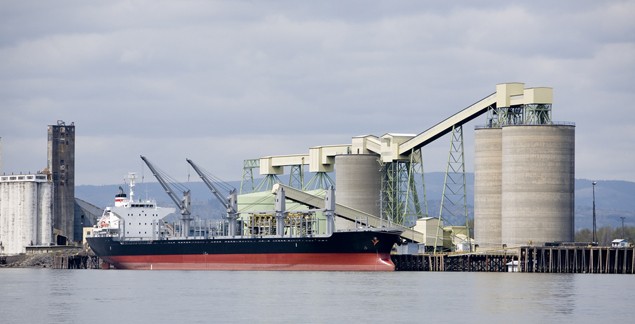Ukraine War Enters New Phase With Oil In The Crosshairs
By Daryna Krasnolutska (Bloomberg) Russia and Ukraine may have struggled to shift things significantly on the battlefield for more than 16 months, but a new phase of the war is moving...


File photo. Loading grain for shipment. Image (c) Shutterstock/David Gaylor
March 22 (Reuters) – The Baltic Exchange’s main sea freight index, which tracks rates for ships carrying dry commodities, firmed for the 18th consecutive day on Friday, as South American grain season boosted the panamax rates.
The overall index, which factors in the average daily earnings of capesize, panamax, supramax and handysize dry bulk transport vessels, reached its highest so far this year, rising 3 points, or 0.32 percent on Friday, to 933 points.
The Baltic’s panamax index climbed 6 points or 0.5 percent to 1,208 points, with average daily earnings up $45 at $9,661.
Panamaxes usually transport 60,000 to 70,000 tonne cargoes of coal or grains.
“Panamax rates continued to be supported by the South American grain season with charterers booking vessels from the Atlantic and the Far East,” RS Platou Markets analyst Frode Mørkedal said.
Average daily earnings for handysize ships were up $51 to $8,036 and those for supramax ships were up $101 to $10,226.
“Although panamax and supramax spot rates are up 69 percent and 29 percent year-to-date, they remain soft by historical standards and hover near breakeven levels,” Wells Fargo analyst Michael Webber said in a note.
“While these rates are a slight improvement off of trough levels, we note that they remain far too low to help beleaguered dry bulk players, and we still see too much supply in the market to model in significant continued improvement,” Webber added.
The capesize index fell 0.47 percent to 1,284 points.
Average daily earnings of capesizes, which usually transport 150,000-tonne cargoes such as iron ore and coal, was down $67 at $4,981.
“Capesize rates slipped to $5,000 daily despite reports of Rio Tinto taking several vessels from Australia to China with iron ore,” analyst Mørkedal said.
Iron ore shipments account for around a third of seaborne volumes on the larger capesizes, and brokers said price developments remained a key factor for dry freight.
Spot iron ore prices were steady, recovering from three-month lows hit last week, amid signals that buyers from top importer China are keen on rebuilding stockpiles.
A modest bounce in Chinese steel prices this week helped iron ore regain some footing, and traders say prices of the raw material could stretch gains in the days ahead. (Reporting by Shrutee Sarkar in Bangalore; editing by James Jukwey)
(c) 2013 Thomson Reuters, Click For Restrictions
Join the gCaptain Club for curated content, insider opinions, and vibrant community discussions.


Join the 105,890 members that receive our newsletter.
Have a news tip? Let us know.
Access exclusive insights, engage in vibrant discussions, and gain perspectives from our CEO.
Sign Up




Maritime and offshore news trusted by our 105,890 members delivered daily straight to your inbox.



Essential news coupled with the finest maritime content sourced from across the globe.
Sign Up